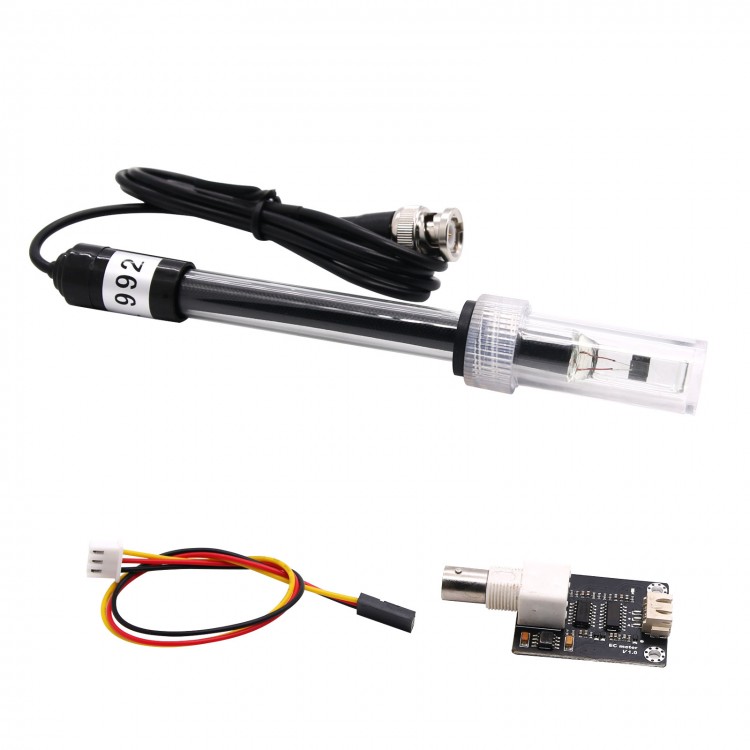
| Quantity | 3+ units | 10+ units | 30+ units | 50+ units | More |
|---|---|---|---|---|---|
| Price /Unit | $44.76 | $43.84 | $42.47 | $40.65 | Contact US |
 5-Wire DC Brushless Fan Testing Board with Storage Box for Internal and External Fan Detection
$25.23
5-Wire DC Brushless Fan Testing Board with Storage Box for Internal and External Fan Detection
$25.23
 New 5000W Pure Sine Wave Inverter Board Motherboard 5KW Over-load Protection (Precharge DC320-500V)
$108.99
New 5000W Pure Sine Wave Inverter Board Motherboard 5KW Over-load Protection (Precharge DC320-500V)
$108.99
 OpenCV OAK-D-Pro Camera Module AI Embedded Machine AI Vision Kit for Depth Measurement/Image Recognition
$587.21
OpenCV OAK-D-Pro Camera Module AI Embedded Machine AI Vision Kit for Depth Measurement/Image Recognition
$587.21
The difference between this product and DTS products is: large range: 1ms/cm--20ms/cm. DTS is suitable for short-range measurement of domestic water quality.
Product introduction
- This analog conductivity meter has the characteristics of simple connection, convenient and practical. After connecting according to the schematic diagram, and then through program control, it is very convenient to measure the conductivity of the solution.
The most important thing is that we open source all the design and code. Users can easily collect conductivity data through Arduino for further control and research. Fans are welcome to research and share and provide valuable feedback.
- Conductivity is the ability of a substance to carry a current and is the reciprocal of resistivity. In the liquid, the electrical resistance of the electrical resistance is often measured by the reciprocal of the electrical resistance. The conductance of water is a very important indicator of water quality, and it reflects the extent of electrolytes present in the water. The degree of conductivity of the solution varies depending on the concentration of the electrolyte in the aqueous solution. In the International System of Units, the unit of conductivity is called Siemens/meter (S/m), and other units are: S/m, mS/cm, μS/cm.
Application range
- Water quality testing
- Water and soil mixed agriculture
- aquaculture
- Ornamental aquarium
Specification:
- Voltage:+5.00V
- PCB size: 45mm × 32mm
- Measuring range: 1ms/cm--20ms/cm
- Applicable temperature: 5-40 ° C
- Accuracy: <±10%F.S. (specific accuracy depends on your calibration accuracy)
- XH2.54 interface (3 foot patch)
- BNC interface type conductivity electrode (electrode constant is 1)
- Conductor electrode cable length: about 60 cm
- Power Indicator
- Wiring diagram
- EC Meter ---- Arduino
V ---- 5.0V;
G ---- GND;
A ---- Analog IO (corresponding to the source code)
Package list:
1x BNC interface type conductivity electrode
1x EC Meter board
1x Adapter cable
Arduino source code:
#include <OneWire.h>#define StartConvert 0#define ReadTemperature 1const byte numReadings = 20; //the number of sample timesbyte ECsensorPin = A1; //EC Meter analog output,pin on analog 1byte DS18B20_Pin = 2; //DS18B20 signal , pin on digital 2unsigned int AnalogSampleInterval=25, printInterval=700, tempSampleInterval=850; //analog sample interval;serial print interval;temperature sample intervalunsigned int readings[numReadings]; // the readings from the analog inputbyte index = 0; / the index of the current reading unsigned long AnalogValueTotal = 0; // the running totalunsigned int AnalogAverage = 0, averageVoltage=0; // the averageunsigned long AnalogSampleTime, printTime, tempSampleTime; float temperature, ECcurrent; //Temperature chip i/oOneWire ds (DS18B20_Pin); // on digital pin 2void setup() { // initialize serial communication with computer: Serial.begin(115200); // initialize all the readings to 0: for (byte thisReading = 0; thisReading < numReadings; thisReading++ ) readings[thisRead Ing] = 0; TempProcess(StartConvert); //let the DS18B20 start the convert AnalogSampleTime=millis(); printTime=millis(); tempSampleTime=millis();}void loop() { /* Every once in a while, */ if(millis()-AnalogSampleTime>=AnalogSampleInterval) { AnalogSampleTime=millis(); // subtract the last reading: AnalogValueTotal = AnalogValueTotal - readings[index]; // read from the Sensor: readings[index] = analogRead(ECsensorPin); // add the reading to the total: AnalogValueTotal = AnalogValueTotal + readings[index]; // advance to the next position in the array: index = index + 1; // if We're at the end of the array... if (index >= numReadings) // ...wrap around to the beginning: index = 0; // calculate the average: AnalogAverage = AnalogValueTotal / numReadings; } /* Every Once in a while, MCU read the temperature from the DS18B20 and then let the DS18B20 start the convert. Attention: The interval between start the convert and read the temperature sh Ould be greater than 750 millisecond, or the temperature is not accurate! */ if(millis()-tempSampleTime>=tempSampleInterval) { tempSampleTime=millis(); temperature = TempProcess(ReadTemperature); // read the current temperature from the DS18B20 TempProcess(StartConvert); //after the reading,start the convert for next reading } /* Every once in a while, print the information on the serial monitor. */ if(millis()-printTime>=printInterval) { printTime= Millis(); averageVoltage=AnalogAverage*(float)5000/1024; Serial.print("Analog value:"); Serial.print(AnalogAverage); //analog average, from 0 to 1023 Serial.print(" Voltage:" Serial;print(averageVoltage); //millivolt average, from 0mv to 4995mV Serial.print("mV "); Serial.print("temp:"); Serial.print(temperature); //current temperature Serial. Print("^C EC:"); float TempCoefficient=1.0+0.0185*(temperature-25.0); //temperature compensation formula: fFinalResult(25^C) = fFinalResult(current)/(1.0+0.0185*(fTP-25.0 )); float CoefficientVolatge=(floa t)averageVoltage/TempCoefficient; if(CoefficientVolatge<150)Serial.println("No solution!"); //25^C 1413us/cm<-->about 216mv if the voltage(compensate)<150,that is <1ms /cm,out of the range else if(CoefficientVolatge>3300)Serial.println("Out of the range!"); //>20ms/cm,out of the range else { if(CoefficientVolatge<=448)ECcurrent=6.84 *CoefficientVolatge-64.32; //1ms/cm<EC<=3ms/cm else if(CoefficientVolatge<=1457)ECcurrent=6.98*CoefficientVolatge-127; //3ms/cm<EC<=10ms/cm else ECcurrent=5.3* CoefficientVolatge+2278; //10ms/cm<EC<20ms/cm ECcurrent/=1000; //convert us/cm to ms/cm Serial.print(ECcurrent,2); //two decimal Serial.println("ms/ Cm"); } }}/*ch=0,let the DS18B20 start the convert;ch=1,MCU read the current temperature from the DS18B20.*/float TempProcess(bool ch){ //returns the temperature from one DS18B20 In DEG Celsius static byte data[12]; static byte addr[8]; static float TemperatureSum; if(!ch){ if ( !ds.search(addr)) { Serial.println("no more sensors on chain, reset Search!"); d S.reset_search(); return 0; } if ( OneWire::crc8( addr, 7) != addr[7]) { Serial.println("CRC is not valid!"); return 0; } if ( addr[ 0] != 0x10 && addr[0] != 0x28) { Serial.print("Device is not recognized!"); return 0